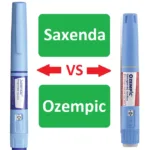Mounjaro Vs Saxenda is a basic comparison of the two highly potent diabetes and weight loss drugs.
Mounjaro is a novel GLP-1 analog approved for the management of patients with Diabetes Mellitus and those who are overweight.
It is an FDA-approved drug containing dual GIP (glucose-dependent insulinotropic peptide) as well as GLP-1 analog (Glucagon-like peptide), known as Tirzepatide.
It was seen that GIP alone does not have a significant benefit on glycemic control. However, when used in combination with GLP-1 analog, a marvelous synergistic effect was seen, and much better glycemic control was observed.
Hence, the name ‘Twincretin’ was used for this combination. Twincretin, as the name suggests, is a combination of two incretins, GLP-1 and GIP.
Whereas Saxenda contains Liraglutide, a GLP-1 analog. It has been approved by the FDA primarily for the treatment of obesity, weight loss, and dyslipidemia.
Saxenda is basically a high-dose Liraglutide, while Victoza is a low-dose Liraglutide. Victoza is approved for the treatment of Diabetes only.
Mounjaro Vs Saxenda
Saxenda and Mounjaro are two potent diabetes and weight loss drugs. These drugs have not been compared in a head-to-head comparative trial.
The following are some of the similarities and differences between the two drugs:
Saxenda | Mounjaro |
Trade Name:
| Trade name:
|
Manufacturer:
| Manufacturer:
|
| Uses: To lower body weight if BMI is more than 30 or more than 27 if associated with at least one weight-related risk factor, such as:
| Uses: It is used in controlling type 2 diabetes mellitus in conjunction with diet and exercise. Tirzepatide has also been approved for weight loss. |
Ingredient:
| Ingredient:
|
| Indication: It is indicated for the treatment of obesity in patients with or without diabetes. It is indicated if the BMI is above 30 or more than 27 with at least one weight-associated medical condition. | Indication: It has been indicated for the control of diabetes with or without other anti-diabetic agents along with dietary control and lifestyle modifications. Currently, it is not approved as a weight loss drug. |
Frequency of administration:
It is available in injection form, at 6 mg/mL, and delivers the following doses:
| Frequency of administration:
It is available as a single-dose pen containing the following doses:
|
Injection method:
| Injection method:
|
Saxenda is administered as a subcutaneous injection daily, while Mounjaro is administered once a week.
The dosing schedule of Saxenda is as follows:
- Week 1:
- 0.6 mg once daily
- Week 2:
- 1.2 mg once daily
- Week 3:
- 1.8 mg once daily
- Week 4:
- 2.4 mg once daily
- Week 5:
- 3 mg once daily
The dosing schedule of Mounjaro is as follows:
- 1 – 4 weeks:
- 2.5 mg once weekly
- 5 – 8 weeks:
- 5 mg once weekly
- 9 – 12 weeks:
- 7.5 mg once weekly
- 13 – 16 weeks:
- 10 mg once weekly
- 17 – 20 weeks:
- 12.5 mg once weekly
- 21 – 24 weeks:
- 15 mg once weekly
The maximum dose of Saxenda is 3 mg once daily, while the maximum dose of Mounjaro is 15 mg once a week.
Efficacy of Mounjaro Vs Saxenda for Diabetes and Weight Loss:
The current FDA approval of Saxenda is primarily for weight loss, while that of Mounjaro is for the treatment of Type 2 Diabetes Mellitus.
The A1C reduction and Weight loss effects of Saxenda Vs Mounjaro are summarized in the table below:
Mounjaro Vs Saxenda: Effect on A1C and Weight | ||
Efficacy | Saxenda | Mounjaro |
Hba1C reduction | Saxenda is not approved for diabetes. However, Liraglutide in a dose of 1.8 mg daily lowered the A1C by 1.1%. | At 40 weeks, Mounjaro has shown a 2% reduction in HbA1c as compared to the placebo. The A1C lowering effect at different doses is:
|
Weight loss | Saxenda reduces body weight by 7 kg. The percentage weight loss with Saxenda is estimated to be around 8 – 11% | Mounjaro is associated with about 21% weight loss at maximum doses. Its weight loss effect at different doses is:
|
Mounjaro (Tirzepatide) is more effective in lowering HbA1C. It’s almost twice as effective as Saxenda (Liraglutide).
Similarly, Mounjaro is associated with greater weight loss compared to Saxenda. Although Mounjaro’s FDA approval as a weight loss drug is still pending, it is twice as effective in reducing body weight compared to Saxenda.
Mounjaro (Tirzepatide) is also more effective than Ozempic and Wegovy as a weight loss drug (21% weight loss vs 16% with Ozempic and Wegovy).
Safety of Mounjaro Vs Saxenda:
Both Saxenda and Mounjaro are incretins, GLP-1 analogs. However, Mounjaro is a “Twincretin”. It is a dual GLP-1 and GIP analog.
The side effects of both Mounjaro and Saxenda are comparable:
Serious side effects:
| |
Saxenda | Mounjaro |
Common side effects:
| Common side effects:
|
Serious side effects:
| Serious side effects:
|
Mounjaro Vs Saxenda Drug Interactions:
Certain drugs, when combined with Saxenda and Mounjaro, may result in a loss of the blood glucose-lowering effects of these drugs. These include corticosteroids, thiazides, and beta-agonists.
Other drugs, such as insulin and sulfonylurea, may result in hypoglycemia when given in combination with Saxenda and Mounjaro.
Drug Interactions |
| Both of these are associated with severe drug reactions when used along with one of the fluoroquinolones called Gatifloxacin. And another drug that is used to treat skin malignancies, called Bexarotene |
Less Severe Drug Interactions |
Hypoglycemia:
Diuretics: Oral, IV, and Topical steroids: Long-acting beta-agonists like Salmeterol which are used in asthma Estrogen-containing drugs like Combined oral contraceptive pills have severe adverse reactions when combined with the use of Saxenda Antivirals like Indinavir, Atazanavir, and Ritonavir cause severe interactions with Mounjaro. Antibiotics including clarithromycin and atypical antipsychotics like clozapine |
Saxenda and Mounjaro: Who should not take these drugs:
There are certain conditions where both these drugs may do more harm than help you. If you have any of the following conditions, seek medical advice and avoid Saxenda and Mounjaro:
Warnings: | |
Saxenda | Mounjaro |
Saxenda should not be used if one of the following is present:
| Mounjaro should not be used if any of the following is present:
|
There are other medical conditions where both Saxenda and Mounjaro may not be contraindicated but you should tell your healthcare provider and be cautious about these conditions.
Seek medical advice if you have any of the following conditions:
Seek medical advice: | |
Saxenda | Mounjaro |
Medical advice should be sought before using Saxenda if:
| Medical advice should be sought before using Mounjaro if:
|
- PURE AND NATURAL CEYLON CINNAMON: Our premium Ceylon cinnamon capsules are made with the finest quality ingredients. Eac…
- RICH IN ANTIOXIDANTS: Packed with natural antioxidants, our Ceylon cinnamon capsules offer a delightful way to enhance y…
- CONVENIENT AND VERSATILE SUPPLEMENT: Our easy-to-consume cinnamon pills are designed for everyone. Whether you’re lookin…
$24.99
- 97% Pure Berberine Powder – High-purity, plant-derived extract with a rich yellow color. Carefully processed and lab-tes…
- Naturally Bitter Taste – Berberine has a strong, naturally bitter flavor. Best enjoyed when mixed with smoothies, tea, c…
- 100g in Resealable Foil Pouch – Packaged in a premium aluminum pouch to protect from moisture and light, keeping the pow…
$23.90
- 5 Delicious Flavors: Freeze-Dried Mango, Freeze-Dried Blueberry, Freeze-Dried Orange, Freeze-Dried Dragon Fruit & Freeze…
- Pure and Natural Ingredients: Our fruit powders are made without synthetic pesticides, GMOs, or harmful chemicals. Each …
- Health Benefits: Our carefully selected fruits are packed with antioxidants, vitamins, fiber, and digestive enzymes to s…
$29.99







